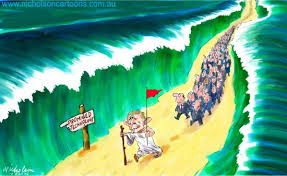 Global warming is the increase in the average temperature of the Earth's near-surface air and oceans since the mid-20th century and its projected continuation. Global surface temperature increased 0.74 ± 0.18 °C (1.33 ± 0.32 °F) during the last century.[1][A] The Intergovernmental Panel on Climate Change (IPCC) concludes that increasing greenhouse gas concentrations resulting from human activity such as fossil fuel burning and deforestation are responsible for most of the observed temperature increase since the middle of the 20th century.[1] The IPCC also concludes that natural phenomena such as solar variation and volcanoes produced most of the warming from pre-industrial times to 1950 and had a small cooling effect afterward.[2][3] These basic conclusions have been endorsed by more than 40 scientific societies and academies of science,[B] including all of the national academies of science of the major industrialized countries.[4]Climate model projections summarized in the latest IPCC report indicate that global surface temperature will probably rise a further 1.1 to 6.4 °C (2.0 to 11.5 °F) during the twenty-first century.[1] The uncertainty in this estimate arises from the use of models with differing sensitivity to greenhouse gas concentrations and the use of differing estimates of future greenhouse gas emissions. Some other uncertainties include how warming and related changes will vary from region to region around the globe. Most studies focus on the period up to 2100. However, warming is expected to continue beyond 2100 even if emissions stop, because of the large heat capacity of the oceans and the long lifetime of carbon dioxide in the atmosphere.[5][6] Increasing global temperature will cause sea levels to rise and will change the amount and pattern of precipitation, probably including expansion of subtropical deserts.[7] The continuing retreat of glaciers, permafrost and sea ice is expected, with the Arctic region being particularly affected. Other likely effects include shrinkage of the Amazon rainforest and Boreal forests, increases in the intensity of extreme weather events, species extinctions and changes in agricultural yields.Political and public debate continues regarding what actions (if any) to take in response to global warming. The available options are mitigation to reduce further emissions; adaptation to reduce the damage caused by warming; and, more speculatively, geoengineering to reverse global warming. Most national governments have signed and ratified the Kyoto Protocol aimed at reducing greenhouse gas emissions.
Global warming is the increase in the average temperature of the Earth's near-surface air and oceans since the mid-20th century and its projected continuation. Global surface temperature increased 0.74 ± 0.18 °C (1.33 ± 0.32 °F) during the last century.[1][A] The Intergovernmental Panel on Climate Change (IPCC) concludes that increasing greenhouse gas concentrations resulting from human activity such as fossil fuel burning and deforestation are responsible for most of the observed temperature increase since the middle of the 20th century.[1] The IPCC also concludes that natural phenomena such as solar variation and volcanoes produced most of the warming from pre-industrial times to 1950 and had a small cooling effect afterward.[2][3] These basic conclusions have been endorsed by more than 40 scientific societies and academies of science,[B] including all of the national academies of science of the major industrialized countries.[4]Climate model projections summarized in the latest IPCC report indicate that global surface temperature will probably rise a further 1.1 to 6.4 °C (2.0 to 11.5 °F) during the twenty-first century.[1] The uncertainty in this estimate arises from the use of models with differing sensitivity to greenhouse gas concentrations and the use of differing estimates of future greenhouse gas emissions. Some other uncertainties include how warming and related changes will vary from region to region around the globe. Most studies focus on the period up to 2100. However, warming is expected to continue beyond 2100 even if emissions stop, because of the large heat capacity of the oceans and the long lifetime of carbon dioxide in the atmosphere.[5][6] Increasing global temperature will cause sea levels to rise and will change the amount and pattern of precipitation, probably including expansion of subtropical deserts.[7] The continuing retreat of glaciers, permafrost and sea ice is expected, with the Arctic region being particularly affected. Other likely effects include shrinkage of the Amazon rainforest and Boreal forests, increases in the intensity of extreme weather events, species extinctions and changes in agricultural yields.Political and public debate continues regarding what actions (if any) to take in response to global warming. The available options are mitigation to reduce further emissions; adaptation to reduce the damage caused by warming; and, more speculatively, geoengineering to reverse global warming. Most national governments have signed and ratified the Kyoto Protocol aimed at reducing greenhouse gas emissions.The cause of global warming
Greenhouse gases
All sources of energy found in the Earth comes from the sun. Most of the energy in the form of short wave radiation, including visible light. When this energy surface of the Earth arrived, he changed from light into heat that warm the Earth. Surface of the Earth, will absorb some heat and toss the rest back. Part of this substantial heat infra red radiation wave length to outer space. However, some heat remains trapped in the earth's atmosphere due pile the amount of greenhouse gases, among others, water vapor, carbon dioxide, and metana the wave radiation into this trap. Gases absorb this radiation and reflect back waves that emanated Earth and consequently heat is stored in the surface of the Earth. These conditions continue to occur so that resulted in an average temperature of the earth continues to increase yearly.
Impact of global warming
Start the Climate Not Stable
The scientis predict that during global warming, the North region of the Earth North (Northern Hemisphere) will heat up more than other areas on the Earth. As a result, the mountains will melt ice and land will decline. would less ice that float on the waters of the North. Areas that previously experienced light snow, it may not will beat again. In the mountains in subtropical areas, the snow-covered will be less and will melt more quickly.
Global temperature tended to increase
People may assume that a warmer Earth will produce more food from the previous, but this is not the same in some places. The Southern Canada, for example, may benefit from the higher rainfall and more long period of planting. On the other hand, agricultural land, semi-tropical dry in some parts of Africa may not be able to grow. Desert agricultural areas that use irrigation water from the mountains far can suffer if the snowpack (the collection of snow) winter, works as a natural reservoir, it will melt before the peak month of the year the plant. Crops and forest insects may attack and a more severe disease.

Tidak ada komentar:
Posting Komentar